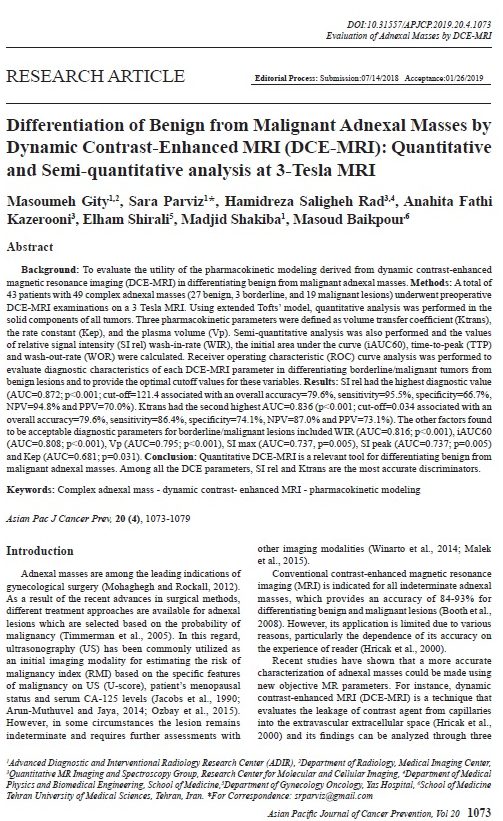Differentiation of benign from malignant adnexal masses by dynamic contrast-enhanced MRI (DCE-MRI): Quantitative and semi-quantitative analysis at 3-tesla MRI
Abstract
BACKGROUND:
To evaluate the utility of the pharmacokinetic modeling derived from dynamic contrast-enhanced magnetic resonance imaging (DCE-MRI) in differentiating benign from malignant adnexal masses.
METHODS:
A total of 43 patients with 49 complex adnexal masses (27 benign, 3 borderline, and 19 malignant lesions) underwent preoperative DCE-MRI examinations on a 3 Tesla MRI. Using extended Tofts’ model, quantitative analysis was performed in the solid components of all tumors. Three pharmacokinetic parameters were defined as volume transfer coefficient (Ktrans), the rate constant (Kep), and the plasma volume (Vp). Semi-quantitative analysis was also performed and the values of relative signal intensity (SI rel) wash-in-rate (WIR), the initial area under the curve (iAUC60), time-to-peak (TTP) and wash-out-rate (WOR) were calculated. Receiver operating characteristic (ROC) curve analysis was performed to evaluate diagnostic characteristics of each DCE-MRI parameter in differentiating borderline/malignant tumors from benign lesions and to provide the optimal cutoff values for these variables.
RESULTS:
SI rel had the highest diagnostic value (AUC=0.872; p<0.001; cut-off=121.4 associated with an overall accuracy=79.6%, sensitivity=95.5%, specificity=66.7%, NPV=94.8% and PPV=70.0%). Ktrans had the second highest AUC=0.836 (p<0.001; cut-off=0.034 associated with an overall accuracy=79.6%, sensitivity=86.4%, specificity=74.1%, NPV=87.0% and PPV=73.1%). The other factors found to be acceptable diagnostic parameters for borderline/malignant lesions included WIR (AUC=0.816; p<0.001), iAUC60 (AUC=0.808; p<0.001), Vp (AUC=0.795; p<0.001), SI max (AUC=0.737, p=0.005), SI peak (AUC=0.737; p=0.005) and Kep (AUC=0.681; p=0.031).
CONCLUSION:
Quantitative DCE-MRI is a relevant tool for differentiating benign from malignant adnexal masses. Among all the DCE parameters, SI rel and Ktrans are the most accurate discriminators.

